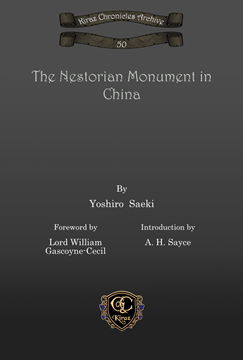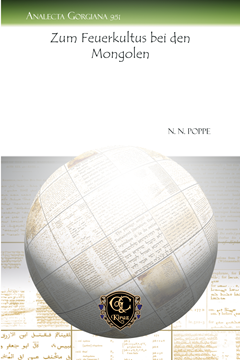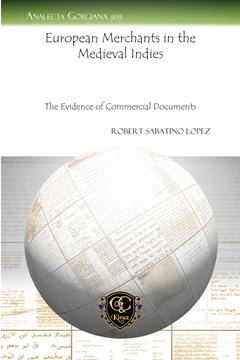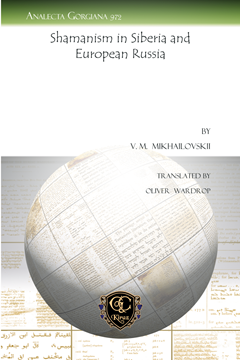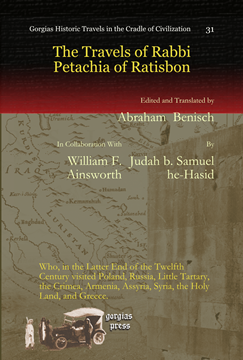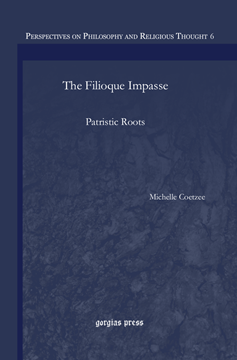The Nestorian Monument in China
Series: Kiraz Chronicles Archive 50
ISBN: 978-1-61143-838-3
The text in Chinese and Syriac, with English translation and notes, of the Nestorian Stele, set up in Changan in 781, with a history of the Nestorian Christians of China and their final state as a secret society.
$203.00 (USD) $121.80 (USD)
Zum Feuerkultus bei den Mongolen
By N. N. Poppe
Series: Analecta Gorgiana 951
ISBN: 978-1-61143-859-8
The fire cult of the Mongols, the names and images of the fire-god, the origins of the cult in Buddhism, its mythic connections, and its festivals.
$34.00 (USD) $20.40 (USD)
A Ruined Nestorian City in Inner Mongolia
Series: Analecta Gorgiana 954
ISBN: 978-1-61143-871-0
Owen Lattimore, a historian of Central Asia, presents the first report on Kwei-hua, the ruined city of the Syriac-Ongut Turks.
$35.00 (USD) $21.00 (USD)
An Eastern Embassy to Europe in the Years 1287-8
Series: Analecta Gorgiana 957
ISBN: 978-1-61143-874-1
Rabban Sauma, a Syriac monk, travelled to Europe in 1287 as a diplomatic representative of the Mongols; this is his own account of his travels, the first translation into English.
$35.00 (USD) $21.00 (USD)
European Merchants in the Medieval Indies
The Evidence of Commercial Documents
Series: Analecta Gorgiana 959
ISBN: 978-1-61143-878-9
Commercial sources on journeying to the east after Marco Polo; the gradual closing of trade between Italy and China or India under the hostile or defensive rulers of the lands in between.
$35.00 (USD) $21.00 (USD)
Shamanism in Siberia and European Russia
By V. M. Mikhailovskii; Translated by Oliver Wardrop
Series: Analecta Gorgiana 972
ISBN: 978-1-61143-905-2
This work presents a detailed first-hand account of shamanic songs, rituals, and healing and initiatory ceremonies from all over Siberia, arranged by tribe.
$39.00 (USD) $23.40 (USD)
The Travels of Rabbi Petachia of Ratisbon
Who, in the Latter End of the Twelfth Century visited Poland, Russia, Little Tartary, the Crimea, Armenia, Assyria, Syria, the Holy Land, and Greece.
Edited and Translated by Abraham Benisch; In Collaboration With William F. Ainsworth; By Judah b. Samuel he-Hasid
Series: Kiraz Historic Travels Archive 31
ISBN: 978-1-61143-911-3
This text narrates the travels of Rabbi Petachia, a medieval rabbi from Regensburg, Germany, who set out to visit Baghdad, Susa, and Palestine.
$153.00 (USD) $91.80 (USD)
Hugoye - Journal of Syriac Studies (volume 14)
2011
General Editor George Anton Kiraz
Series: Hugoye: Journal of Syriac Studies 14
ISBN: 978-1-61143-926-7
Widely regarded as a premier journal dedicated to the study of Syriac, Hugoye: Journal of Syriac Studies was established in 1998 as a venue devoted exclusively to the discipline. An organ of Beth Mardutho, the Syriac Institute, the journal appears semi-annually and will be printed in annual editions. A peer-reviewed journal, Hugoye is a respected academic source for up-to-date information about the state of Syriac studies and for discovering what is going on in the field. Contributors include some of the most respected names in the world of Syriac today.
$75.00 (USD) $45.00 (USD)
Iconea 2009-2010
Proceedings of the International Conference of Near Eastern Archaeomusicology. Université de la Sorbonne Paris IV November 25, 26 and 27, 2009 and at the University of London, Senate House December 13, 14 and 15, 2010
Edited by Richard Dumbrill & Irving Finkel
Series: Iconea 1
ISBN: 978-1-4632-0182-1
ICONEA is the only publication exclusively dedicated to the archaeomusicology of Near and Middle Eastern cultures from its Sumerian origins to the dawn of Christianity. ICONEA also publishes papers of comparative archaeomusicology with contemporaneous neighbouring cultures.
$94.00 (USD) $56.40 (USD)
The Filioque Impasse
Patristic Roots
ISBN: 978-1-4632-0255-2
A fascinating study of the underlying reasons for the disagreement over the clause “and the Son” in the Western version of the Niceno-Constantinopolitan creed, which contributed to the schism between Eastern and Western Christians. Coetzee argues that there has been a great deal of misunderstanding of the positions of each tradition by the other, partly due to the fact that East and West imbue certain key words, such as ‘person’ and ‘unity’, with different meanings which Coetzee believes come from different understandings of Hellenic philosophy. Against this backdrop, Coetzee sets about clearing up some of the misunderstandings.
$154.00 (USD) $92.40 (USD)
